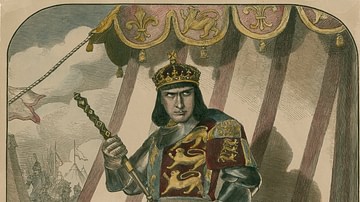
Edward of Woodstock (1330-1376 CE), better known as the Black Prince after his distinctive armour or martial reputation, was the eldest son of Edward III of England (r. 1327-1377 CE). Made the Prince of Wales in 1343 CE, Edward would fight with distinction at both of England's great victories against the French during the first phase of the Hundred Years' War (1337-1453 CE): Crécy in 1346 CE and Poitiers in 1356 CE when he captured the king of France. Another famous victory would come at Najera in Spain in 1367 CE, but illness struck the prince down before he could be crowned the great king everyone hoped he would become. Edward died, probably of dysentery, on 8 June 1376 CE. He was buried in Canterbury Cathedral where his effigy and original black helmet and shield are still hung on display.
Early Life & Titles
Edward was born on 15 June 1330 CE in Woodstock near Oxford, the eldest son of Edward III of England and Philippa of Hainault (c. 1314-1369 CE). The prince received his first suit of armour aged just seven and he would indeed turn out to be one of the greatest warriors England ever produced. Around the same time, in March 1337 CE, King Edward ensured his son would have sufficient funds by granting him revenue from the newly created Duchy of Cornwall. If a future monarch did not have a son, then the revenue from the duchy reverted to the Crown. Consequently, Prince Edward was now made the Duke of Cornwall, which went with his other title, Earl of Chester. In 1343 CE Edward was made the Prince of Wales, too.
As for his other more famous name, it was not until the 16th century CE that Edward became known as the 'Black Prince', most likely because of his distinctive black armour and/or jousting shield. His tournament helmet hung above his tomb is black with a large moulded leather lion (or leopard) on top of it. His nickname, however, may have been given to him by the French for his martial reputation and the terrible scorched-earth strategy he repeatedly used against them. Another of the Black Prince's emblems was three white ostrich feathers set against a black background, and still today, the ostrich feathers are used as the symbol of the Prince of Wales.
Edward cast a tall and striking figure, and he married his first cousin Joan, the countess of Kent (1328-1385 CE) in 1361 CE at Windsor Castle. Joan had been married before but it seemed to be third husband lucky in a union that suggested more love was involved than in the usual medieval royal marriage made only to cement political alliances. The couple would have two sons: Edward (d. 1371 CE) and Richard (b. 1367 CE), who would become Richard II of England (r. 1377-1399 CE). The Black Prince displayed great piety throughout his life, contributing generously to Canterbury Cathedral and making pilgrimages to Walsingham and Canterbury before his famous battles in France. He also held the Holy Trinity in great reverence, as can be seen at his tomb.
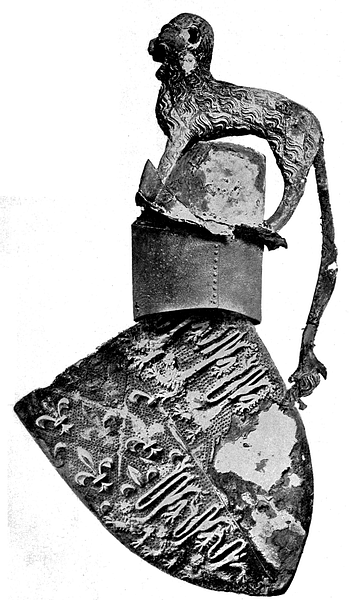
Hundred Years' War
In 1337 CE Edward III of England was intent on expanding his lands in France and he had the perfect excuse as via his mother Isabella of France (b. c. 1289 CE and the daughter of Philip IV of France, r. 1285-1314 CE), he could claim a right to the French throne. Naturally, the current king, Philip VI of France (r. 1328-1350 CE), was unwilling to step down and so the Hundred Years' War between France and England began (actually a 19th-century CE label for a conflict which rumbled on intermittently for well over a century, in fact, finally ending in 1453 CE). Just prior to the great battles of the war, Prince Edward was knighted by his father on 12 July 1346 CE along with a number of other young knights.
Battle of Crécy
Edward the Black Prince was first charged with torching as many French towns and villages as he could through 1346 CE. This strategy, known as chevauchée, was a common enough part of medieval warfare and had been used at least as far back as 1066 CE by William the Conqueror. The aims of the strategy were multiple: to strike terror into the locals, provide free food for an invading army, acquire booty and ransom for noble prisoners, and ensure the economic base of one's opponent was severely weakened, making it extremely difficult for them to later put together an army in the field. Inevitably, ordinary troops also took the opportunity to cause general mayhem and loot whatever they could from the raids. This was a brutal form of economic warfare and, perhaps, too, it was designed to provoke King Philip into taking to the field and facing the invading army, which is exactly what happened.
On 26 August 1346 CE the two armies met and Edward, then aged just 16, led the English army's right wing alongside Sir Godfrey Harcourt. The prince fought with aplomb, but there had been a moment of great danger when the French seemed about to overwhelm the Prince's troops. Sir Godfrey called for reinforcements but, according to the medieval chronicler Jean Froissart (c. 1337 – c. 1405), writing in his Chronicles, on hearing of his son's plight King Edward merely stated that if his son could extricate himself from his difficulties then he would win his spurs that day (spurs being a mark of knighthood and presumably to be awarded to Edward in his full knighting ceremony when he got back home).
In the end, Edward III's army overcame their numerical disadvantage (around 12,000 v. 25,000) by taking a defensive position on a rise overlooking the River Maie. The French troops got into a muddle when a charge was ordered and then retracted, and the Welsh and English archers proved as devastating as ever. King Edward's army also benefitted from its battle experience and discipline gained fighting in Scotland and Wales and from the king's emphasis on light mobile troops, not to mention the first use of cannons on French soil. King Edward won the battle with around 300 casualties compared to the 14,000 fallen French, the massacre a result of the French having raised their banner to give no quarter. The flower of France's nobility and that of its allies was eliminated, including King John of Bohemia (r. 1310-1346 CE), the Count of Blois, and the Count of Flanders. It was after the battle, at least according to legend, that Prince Edward adopted the emblem and motto of the fallen King of Bohemia - the ostrich feathers mentioned above and Ich Dien or 'I serve'.
The English successes continued when Edward III and the Black Prince, backed by an army numbering around 26,000 men, ensured Calais was captured in July 1347 CE after a year-long siege. Three years later, in January 1350 CE, the Black Prince and a select unit of knights were involved in the city's successful defence against a French plot involving Italian mercenaries. The Black Prince's reputation as a great medieval knight was already secure but his star would yet rise even higher.
Chivalry & Garters
The Black Prince seems to have enjoyed the pomp and ceremony of medieval tournaments just as much as his father and he participated in the great 15-day tournament of 1344 CE at Windsor Castle. The prince was also a founder member of his father's new and exclusive knight's club and epitome of medieval chivalry, the Order of the Garter (c. 1348 CE). This order, England's oldest and still most prestigious, was created with only 24 chosen knights plus the king and the Black Prince. All of its first members had fought at the Battle of Crécy; these were men of valour not just rank. The symbol of this order is a garter (then worn on the upper arm or upper leg over armour) and its motto is Honi soit, qui mal y pense or 'Evil be on him who thinks it', most likely a reference to anyone who doubted the king's right, as he saw it, to rule France. It is no coincidence that the garter also had the royal colours of France - gold and blue.
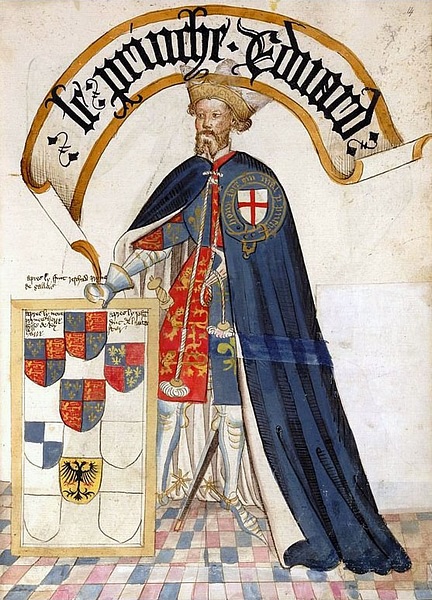
Battle of Poitiers
A new king, John II of France (r. 1350-1364 CE), continued the war with England but committed the same errors as his predecessor on the battlefield. In 1355-6 CE, the Black Prince raided Gascony and captured Bordeaux which he thereafter used as his base for further sorties. The region was a major contributor to the French king's coffers, and so Edward systematically torched cities and farmlands as he had done before Crécy. It once again provoked a French king to unwisely take to the field in open battle. As it happened, a French army, aiming to prevent the English armies in the southeast from linking up with those in Normandy, surprised the Prince's force on 18 September 1356 CE. The next day a mighty battle ensued 4 miles from Poitiers in the mixed terrain of vineyards, woods, and marshes.
Again the French outnumbered their opponents (35,000 v. 7,000) and again muddled leadership and an outdated reliance on heavy cavalry and crossbows annulled their advantage. Once more the French could not find an answer to the range, power and accuracy of the English longbow. Around 2,000 French knights, including King John himself, were captured, providing a huge potential for cash ransoms. The Black Prince won further distinction for his chivalrous treatment of his royal prisoner who was escorted by Edward to England where he would have to wait four long years for his release. The prince gained a reputation for largesse amongst his own loyal followers, too, one of the key qualities of a noble knight, by distributing gold and titles to his commanders as well as donating handsomely to churches such as Canterbury Cathedral.
King Edward was then audacious enough to march on Rheims in 1359 CE, fully intending to have himself made king of the French where their monarchs were traditionally crowned. The king and the Black Prince led the army and marched on the city, but Rheims proved impregnable and a harsh winter so reduced Edward's army he was obliged to start peace talks. In May 1360 CE a peace treaty was signed between England and France, the Treaty of Brétigny.
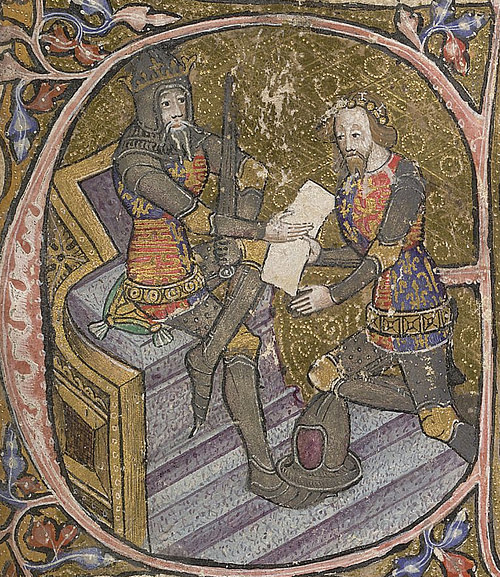
In 1362 CE Prince Edward was made the Prince of Aquitaine by his father. The war with France, though, was about to take a turn for the worse as Edward III faced his third French king: Charles V of France, aka Charles the Wise (r. 1364-1380 CE) who proved by far the most capable of the trio. Charles began to grab back in earnest what his predecessors had lost by avoiding open battle and concentrating on harassment and relying on the safety of his castles when required. The English king was also now struggling to pay for his hugely expensive wars.
Castile & Najera
During the peace that followed the Treaty of Brétigny, the Black Prince directed his martial passions towards Castile in Spain. Here in 1367 CE, Pedro I (r. 1350-1366 CE) hoped to reclaim the throne he had lost to his half-brother Henry II of Castile (r. 1366-1367 & 1369-1379 CE). Pedro's ambiguous reputation is indicated by his contrasting nicknames: 'the Cruel' and 'the Just'. It had been arranged for Pedro to marry Joan, daughter of Edward III of England but she had died en route when she was travelling through an area hit by the Black Death plague. Henry II of Castile, meanwhile, had the support of the French. In effect, then, Spain became an arena for England and France to continue their rivalry without fighting on either party's territory.
On 3 April 1367 CE Edward famously led a combined Gascon and English army to victory at the Battle of Najera (Navarette), once more employing longbow archers and fast-moving infantry to great effect. Edward concentrated on his enemies left flank and in the ensuing panic, the French were driven back into the Najerilla river by a final cavalry charge.
After the battle, Edward even managed to capture and sell for a massive ransom one of his rivals for the title of greatest ever knight, Bertrand du Guesclin, the 'Eagle of Brittany' (c. 1320-1380 CE). Edward had allowed du Guesclin to name his own ransom which he did, rather vainly choosing the outrageously high fee of 100,000 Francs. However, in the larger scheme of things, Pedro proved reluctant or simply unable to pay Edward and his army for their trouble, and all the Black Prince took away was health problems - perhaps malaria or oedema (dropsy) - which would plague him for the rest of his life. Another unfortunate consequence was the discontent of his subjects in Aquitaine who had been heavily taxed to pay for the whole escapade.
The Black Prince did at least receive a memento from Pedro, the stone that has become known as the Black Prince's Ruby, actually a balas or spinel but long-considered a true ruby. This irregular-shaped stone was then set into various crowns belonging to the British Crown Jewels and today takes pride of place at the centre of the Imperial State Crown. Despite the jewels and ransoms, though, Najera was at once a glittering military victory and a financial disaster for the Black Prince.
Return to France: Limoges
The Black Prince was needed back in France where Charles V was back on the offensive and nibbling away at English-held lands where discontent over Edward's taxes was rife. In 1370 CE Limoges was recaptured but the Black Prince did lasting damage to his reputation, at least in France (where it was quite low already), by ordering the execution of some 3,000 men, women and children, perhaps in vengeance for his former ally the Bishop of Limoges switching sides. The city was then torched.
Edward's recurring illness meant he often had to be carried on a litter, and his lack of verve proved telling to the English cause in his later years. Further English invasions in 1369 and 1373 CE led by Edward's younger brother John of Gaunt, the Duke of Lancaster (1340-1399 CE) also proved disappointing, and the Black Prince was obliged to return to England in 1371 CE as his health deteriorated. Consequently, Charles V overran most of Aquitaine in 1372 CE, and by 1375 CE, the only lands left in France belonging to the English Crown were Calais and a thin slice of Gascony, a meagre return for decades of effort and expense.
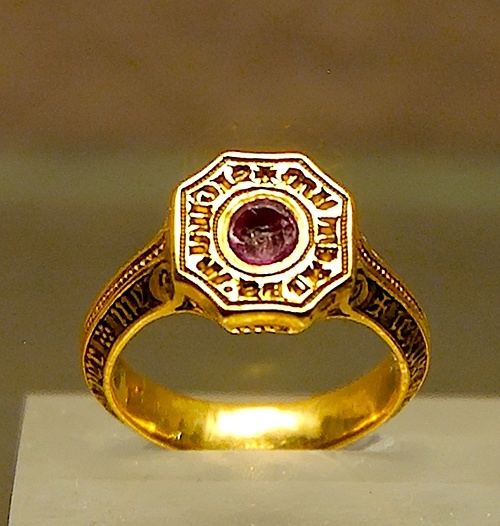
Death & Burial
Prince Edward was 46 when he died on 8 June 1376 CE, probably of dysentery, and a nation mourned. Edward's tomb, as he had wished, lies in Canterbury Cathedral where the prince's black helmet, shield, and gauntlets were originally hung above it. The gilded copper effigy of the prince shows him in full armour and wearing the quartered coat of arms of his father, which mixed the lions of the Plantagenets with the fleur-de-lis of the French crown, symbolic of the English claim to France which the prince had done so much to try and make a reality. The Black Prince's son Richard would be selected by parliament as Edward III's official heir, and he was crowned Richard II of England on 16 July 1377 CE at Westminster Abbey. The Black Prince left his son and all others who followed a warning in the form of a French poem he insisted was inscribed around his tomb at Canterbury:
Such as you are, sometime was I.
Such as I am, so you shall be.
I thought little of Death
So long as I enjoyed life.
On earth I had great riches…
Land, houses, great treasure, horses, money, gold…
But now I am a poor captive,
Deep in the ground I lie…
My great beauty is all gone,
My flesh is wasted to the bone…
(quoted in Jones, 524)



